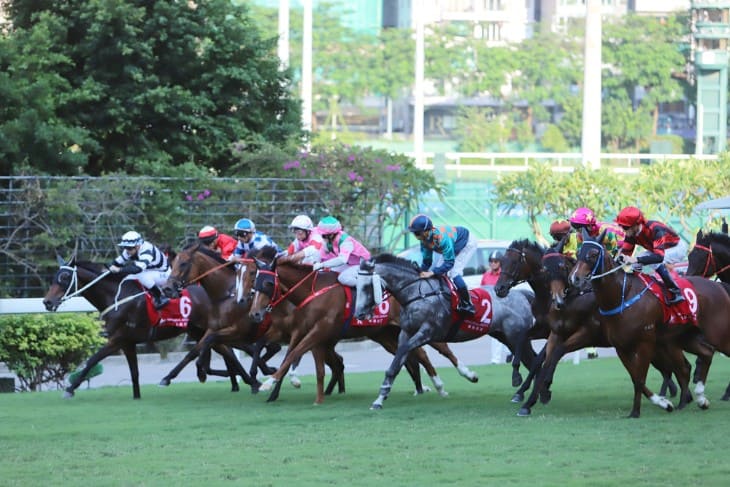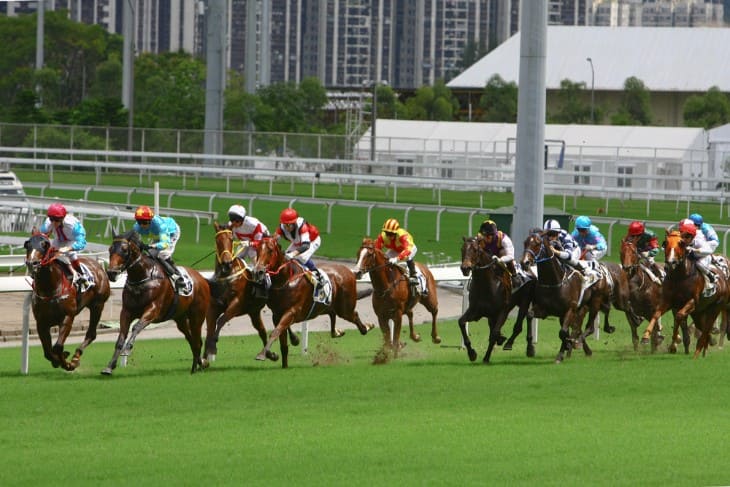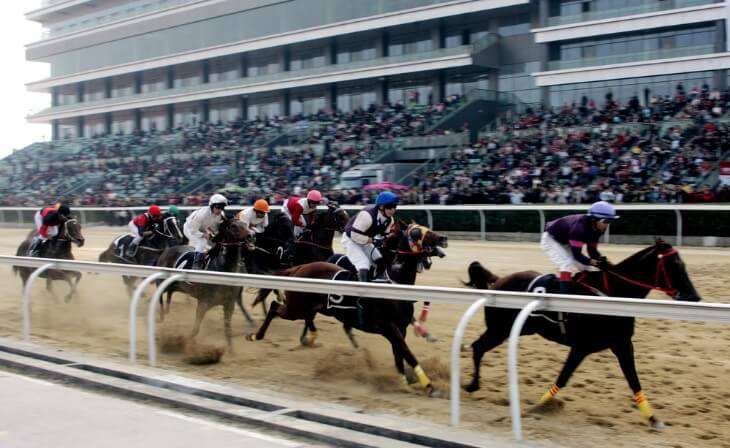Introduction
Horse racing: a sport of speed, endurance, and raw determination. But there's more to the story than just the horses thundering down the track. Look around the stands, and you'll see a sea of excited faces, a symphony of cheers and gasps, a crowd that's as much a part of the spectacle as the horses themselves. In this article, we delve into the intriguing world of how crowds affect horse racing performance. From historical anecdotes to modern-day analyses, we'll uncover the fascinating ways in which the presence of a crowd can make or break a race.
Picture yourself at a racecourse, the air crackling with anticipation, the hum of the crowd reverberating through your bones. It's a scene that's been playing out for centuries. From the earliest days of horse racing, the crowds have been an integral part of the sport. But have you ever wondered how these spectators impact the horses on the track?
As we kick off our exploration, let's take a moment to understand the scope of this study. We're not just talking about the size of the crowd; we're delving into the psychology of horses, the science of noise, the strategies of jockeys, and even the way bets are placed. It's a comprehensive dive into the factors that converge to create that electrifying atmosphere on race day.
A Historical Perspective
To truly grasp the impact of crowds on horse racing performance, we need to step back in time. Horse racing, steeped in history, has seen its fair share of moments that demonstrate how spectators can sway the outcome of a race. From the early days of local village contests to the grandeur of the Derby, crowds have always been there, cheering for their favourites, urging horses to push their limits.
Consider the first Derby in 1780. As Tattenham Corner saw its inaugural race, spectators thronged the sidelines, their roars and cheers echoing across the heath. The exhilaration in the air was palpable, and it's said that the crowd's energy spurred Diomed, the victor, to surge forward in those final moments.
And then there's the legendary tale of Devon Loch, the horse that famously stumbled just before the finish line in the 1956 Grand National. The collective gasp from the crowd seemed to hang in the air as the horse faltered, leaving victory tantalizingly out of reach. Was it the sudden surge of noise that caused the stumble? While we can't definitively say, it's a stark reminder of the role crowds play in the drama of racing.
The Psychology of Horses
Horses, remarkable creatures with their own unique personalities and sensitivities, form the heart of the racing spectacle. As we delve into the psychology of these magnificent animals, it becomes clear that their reactions to external stimuli, including the presence of a crowd, are far from arbitrary.
Horses possess a heightened sensitivity to their surroundings, a trait that has evolved over centuries of survival in the wild. Their acute senses allow them to detect the faintest rustle in the grass, the distant approach of a predator, or the subtlest change in the environment. In the context of a racecourse, this sensitivity translates into a capacity to pick up on the energy of the crowd.
When a racecourse swells with spectators, horses often respond with heightened alertness. The collective hum of voices, the shuffling of feet, the sudden bursts of cheers — all contribute to an atmosphere that's intense and charged. For some horses, this can lead to a surge of adrenaline, spurring them to run faster. For others, the unfamiliar cacophony can evoke nervousness, impacting their focus and composure.
This heightened sensitivity isn't limited to just the auditory cues. Horses are also acutely attuned to visual and tactile signals. The sight of waving flags, colourful banners, and animated gestures from the crowd can either add to their excitement or unsettle their concentration. A gentle pat or an unexpected jostle from the sidelines can influence their reactions, potentially affecting their performance on the track.
For more information read: Psychology in Horse Racing: How it Affects Jockeys and Horses.
The Influence of Crowd Size
Now that we've glimpsed into the intricate psyche of horses, let's tackle the question of crowd size. Does it matter if a racecourse is packed to the brim with spectators or if it's a more intimate gathering? The answer, as it often is, lies in the balance.
Research indicates that both small gatherings and large crowds can impact equine performance, but in varying ways. Small groups can create an atmosphere of familiarity, where horses might feel less overwhelmed by the environment. On the flip side, larger crowds bring more energy and excitement to the table, potentially igniting a fire within the horses to perform better.
However, it's not just about the size; it's also about the dynamic of the crowd. A tightly-knit group of fervent fans can generate as much fervour as a massive crowd, and their proximity to the track can make the experience more intense for the horses. Conversely, a sprawling crowd might have a diluted effect if the noise doesn't reverberate close to the course.
Studies examining the correlation between crowd size and race outcomes offer intriguing insights. There's evidence suggesting that races with medium-sized crowds tend to produce more consistent results, indicating that horses might find a balance between motivation and distraction in such environments. But, as with all things in horse racing, individual variability plays a significant role. Some horses thrive amidst the frenzy of a large crowd, while others excel when the energy is contained within a smaller gathering.

Noise Levels and Start Line Behavior
As the starting gates open and the race begins, one can't help but notice the collective roar of the crowd. It's a crescendo of excitement that reverberates through the air, but how does this auditory onslaught impact the horses at the starting line? The answer lies in the delicate balance between motivation and nervousness.
The noise generated by the crowd can have varying effects on different horses. Some horses respond to the cacophony with a surge of adrenaline, using the energy to catapult themselves off the starting line. For them, the crowd's cheers become a powerful motivator, pushing them to showcase their speed and strength.
However, not all horses react positively to the auditory assault. The sharpness of the crowd's roars can agitate more sensitive individuals, causing them to become jittery or even balk at the starting line. The suddenness of the noise can disrupt their focus, hinder their coordination, and potentially lead to a less-than-optimal start.
This complex relationship between noise and behaviour highlights the fine line that jockeys and trainers must tread. They need to prepare their horses to handle the auditory onslaught without succumbing to nervousness. It's a delicate dance of conditioning, ensuring that the horse remains focused while harnessing the crowd's energy to their advantage.
Navigating the Race Course
Beyond the starting line, the course unfolds with a series of obstacles and challenges. From hurdles to jumps, from tight turns to straight sprints, the racecourse demands both precision and power. But how do horses navigate these hurdles when surrounded by a crowd of spectators?
The answer lies in their innate athleticism and their ability to adapt to changing environments. Horses, as flight animals, are hardwired to assess and react to obstacles in their path. This natural agility is further honed by training and experience, enabling them to adjust their pace, stride, and jump technique according to the demands of the course.
However, the presence of a crowd adds an extra layer of complexity. Horses not only have to contend with the physical challenges of the course but also with the visual and auditory distractions posed by the onlookers. Imagine the energy required to clear a hurdle while being aware of the moving figures in the stands and the thunderous applause echoing in their ears.
Trainers often incorporate techniques to simulate race day conditions during training, exposing horses to noise, commotion, and the presence of people. This helps the horses become accustomed to the tumultuous atmosphere and teaches them to maintain their focus despite the distractions. Additionally, jockeys play a pivotal role in guiding their mounts through the course, providing reassurance and direction to ensure a smooth and agile performance.
Jockeys and Crowd Influence
While the horses are the stars of the show, let's not forget the skilled individuals who guide them to victory: the jockeys. These riders possess an intimate understanding of their horses' temperament and capabilities, making them a crucial factor in the equation of crowd influence.
Jockeys are seasoned professionals who've honed their craft through years of experience. They understand that each horse is unique, with its own quirks and reactions to the environment. When it comes to managing the effects of the crowd, jockeys play a pivotal role in either mitigating or leveraging the influence.
Experienced jockeys know how to maintain their horses' focus amidst the noise and chaos. They communicate subtly through the reins, their body language, and their voice, offering a calming presence that can reassure nervous horses. They also have an innate sense of timing, knowing when to encourage their mounts and when to hold them back, all while navigating the intricacies of the racecourse.
Strategic thinking is another weapon in the jockey's arsenal. They might choose to position their horse strategically in the pack, shielding them from the full force of the crowd's energy or using the slipstream of other horses to their advantage. In some cases, they might even use the crowd's energy to drive their horses forward, leveraging the atmosphere to create a surge of momentum.
It's a dynamic dance between horse and rider, where communication and intuition play vital roles. The partnership between the jockey and the horse is what transforms the tumultuous environment into a canvas of opportunity. With the right jockey at the helm, a nervous horse can become a fierce competitor, and a confident horse can channel the crowd's energy into a winning performance.
For more information: The Role of Jockeys in Horse Racing.
An Analysis of Betting Patterns
Beyond the visceral experience of the crowd's presence, there's a more subtle, yet equally influential, connection between the audience and the race: betting. The wagers placed by spectators create a symbiotic relationship, influencing both the crowd's enthusiasm and the horse's performance.
Betting markets are often a reflection of the collective sentiment. A surge of wagers on a particular horse can create a buzz of excitement, turning that horse into a crowd favourite. Conversely, a sudden shift in betting patterns can hint at a perceived change in a horse's condition, leading the crowd to reassess their expectations.
Interestingly, this interplay can create a feedback loop. The crowd's energy can influence the odds, and the odds, in turn, can impact the crowd's energy. It's a fascinating cycle where perceptions are shaped by a combination of factual information, historical performance, and the collective intuition of the spectators.
The presence of betting adds another layer of complexity to the horse racing ecosystem. It's not just about the physical attributes of the horses or the atmosphere created by the crowd. It's a dynamic network of interactions where information, emotions, and financial stakes converge to create an intricate web of influence.
Case Studies and Notable Races
In the world of horse racing, every race is a story waiting to be told. Some stories, however, stand out in the annals of history due to their remarkable display of the impact of crowds on performance. These are the races that encapsulate the very essence of the relationship between horses and spectators.
Take the case of the 2012 Epsom Derby, a prestigious race with a storied history. The stands were brimming with eager spectators, their excitement palpable in the air. The favourite, Camelot, was touted to secure victory with ease. However, as the race unfolded, a quiet determination seemed to emanate from the crowd. Their collective will seemed to propel the underdog, Mickael Barzalona-ridden "Encke," to an unexpected victory. It was a moment that showcased the unpredictable power of a fervent crowd to shape the destiny of a race.
Similarly, the Grand National has a tradition of unpredictable outcomes influenced by the atmosphere of the crowd. The 1967 Grand National is etched in history as the "Foinavon" race, named after the unlikely winner. A chaotic pile-up at the 23rd fence caused confusion and disruption, allowing Foinavon to take advantage of the chaos and jump to an unassailable lead. The crowd's astonishment at this underdog victory became part of the race's legend.
These stories remind us that the impact of crowds is more than just a statistical variable. It's an intangible force that weaves itself into the very fabric of horse racing, occasionally leading to astonishing upsets and remarkable triumphs. The crowd's energy, their belief in the underdogs, and their unabashed passion create an environment where the unexpected can flourish.

Training and Preparation Strategies
Behind every successful horse on race day is a team of trainers and handlers who've meticulously prepared them for the demands of the track. The role of these experts is crucial in ensuring that horses not only cope with the energy of the crowd but also thrive in its presence.
Trainers understand that the preparation isn't just about physical conditioning; it's about mental fortitude. Horses are gradually exposed to the various stimuli they'll encounter on race day, including noise, movement, and the presence of people. This process helps desensitize them to the distractions, ensuring that they remain focused on their task despite the commotion.
Additionally, training techniques involve fostering a sense of trust between the horse and its handlers. When a horse trusts its rider and trainer, it's more likely to follow their cues, even in the midst of a tumultuous environment. This bond can make a crucial difference on race day, when the horse relies on its handlers to provide reassurance and guidance.
Conclusion
And so, we reach the final furlong of our exploration into the impact of crowds on horse racing performance. We've traversed the history, psychology, and strategies that underpin this intricate relationship. What have we learned from this journey?
First and foremost, it's clear that crowds are not just passive observers in the realm of horse racing. They are active participants, infusing the atmosphere with energy, emotion, and anticipation. The cheers, the roars, the collective gasps — all create a palpable current that horses can feel, responding in a multitude of ways.
The psychology of horses has shown us that they are attuned to their environment, sensitive to the sights, sounds, and movements that surround them. The challenge lies in harnessing this sensitivity to work in their favour, transforming nervousness into energy and excitement into motivation.
From the starting line to the final stretch, we've seen how the crowd's influence is woven into every aspect of the race. Jockeys strategically navigate the course, harnessing the crowd's energy to spur their horses forward. Betting patterns create a dynamic interplay between expectations and performance, shaping the narrative of each race.
Case studies and notable races have proven that the crowd can be a powerful force, capable of tipping the scales of victory. Unexpected triumphs and surprising upsets stand as testament to the unpredictable impact of a passionate audience.
Trainers and handlers play a pivotal role in preparing horses for the grand stage. Through careful desensitization and trust-building, they equip the horses to tackle the challenges presented by a bustling racecourse.







